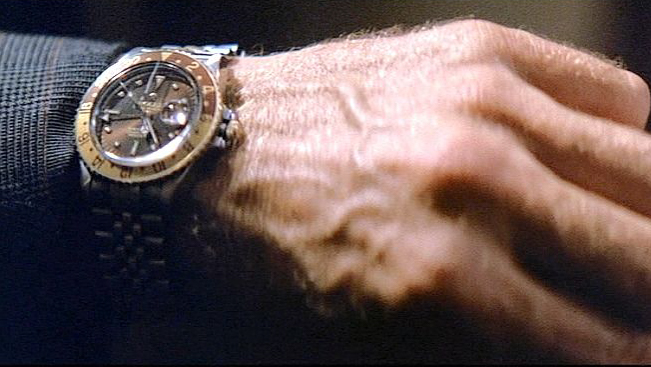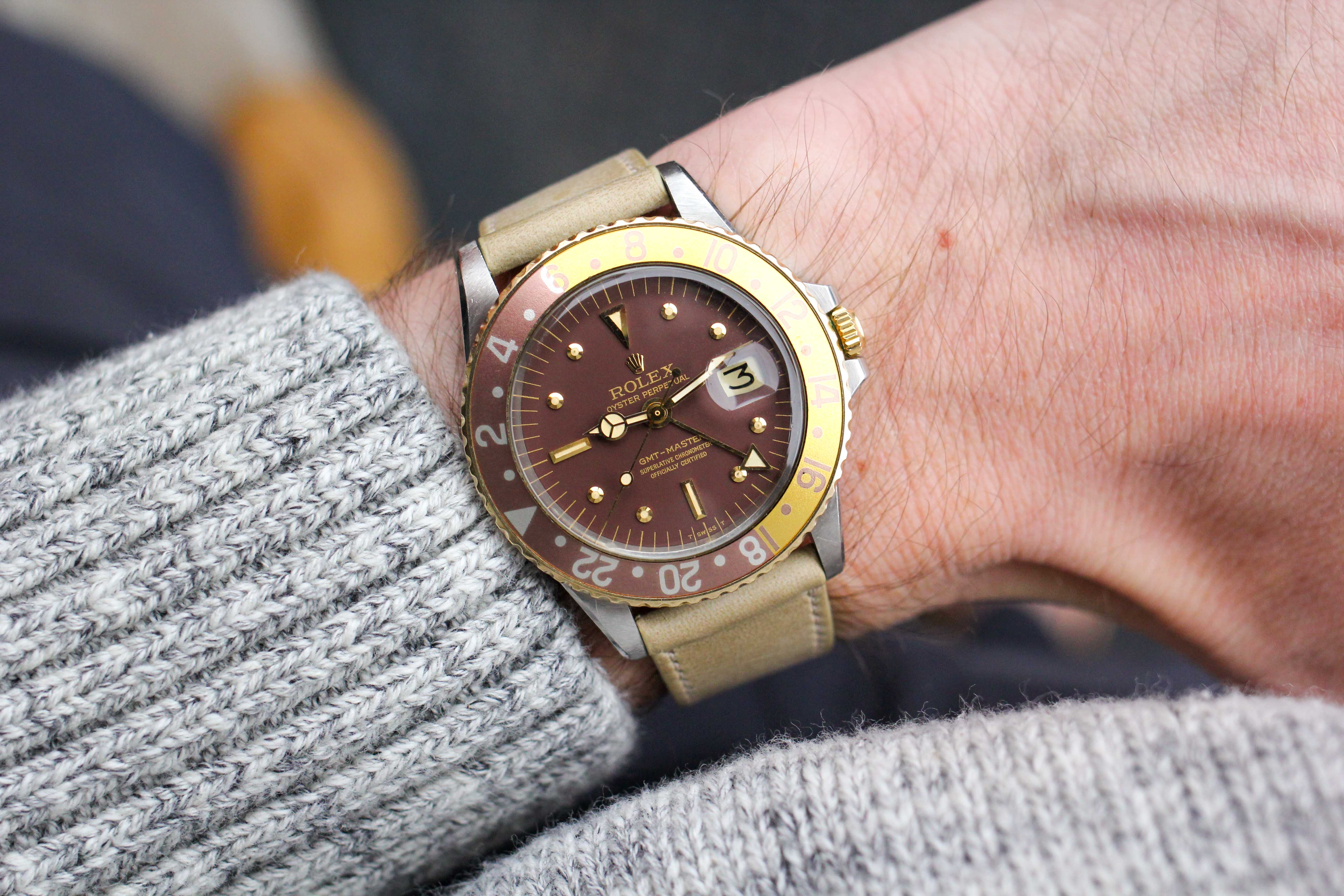There are a number of watches that have become iconic after being worn by celebrities at the heights of their respective careers. Steve McQueen had his Heuer Monaco, some guy named Paul Newman had his Rolex Daytona, and a slew of race drivers in the 1960’s now have watches that bear their names (Jim Clark even got two!). But there’s another celebrity who was often captured wearing a single watch who doesn’t get nearly as much recognition: Clint Eastwood and his two-tone GMT Master.
The “Eastwood” GMT is a pretty deep cut within Rolex’s historical catalog. The watch began production in the early 1970’s and has been continuously produced over the following decades (with a few tweaks), but they’re less common than their Pepsi brethren. In fact, prior to purchasing this 1675/3 GMT Master, I had never seen one in-person, despite attending countless get-togethers with wide-ranging spreads of watches on the table. Two-tone watches may be having a mini-renaissance, but these early GMTs have more often been associated with retirees in Florida than one of the most accomplished and revered actors in Hollywood history. I can’t really dispute that view either, as it was largely how I viewed the watches for years.

Before we go further with my own interest in the reference 1675/3, it’s important to discuss the overall importance of the watch’s namesake. In Hollywood’s long, winding history, there have been few people like Clint Eastwood. A bonafide icon, he burst onto the scene in the 1960’s in a number of well-known spaghetti Western films (The Man With No Name Trilogy) before taking the role of Harry Callahan in Dirty Harry, in which he portrayed a ruthless cop in the San Francisco Police Department. Over the ensuing decades, he would go on to star in or direct more than 70 films and would win five Oscars as both an actor and director, cementing his status as one of the most influential people in the history of film.
It wasn’t until the 1980’s, however, that his GMT Master would begin making appearances in a string of movies – which is a bit of a rarity when it comes to watches with nicknames. Many “nicknamed watches” appear in single photographs, races, or iconic movies, but are rarely seen over a sustained period. Eastwood’s GMT Master, on the other hand, makes prominent appearances in Firefox (1982), Tightrope (1984), and In The Line of Fire (1993), with a number of close-ups and glamour shots such as the one below (from Firefox) and this clip from In The Line of Fire. In my opinion, this is an important part of the watch’s legacy – instead of being a contrived connection to Eastwood through the collector community, this particular GMT was a staple in his life for many years.

All of that context is necessary in order to fully ponder the “Eastwood GMT’s” general lack of notoriety in the collecting community. Poll some of the more prominent collectors of vintage Rolex and you’re unlikely to find many who wax poetic about the root beer GMT’s virtues. An intriguing oddball, sure, but not a watch that will inspire fawning from people on the other side of a table. As I mentioned earlier, my first opinion of the root beer GMT was that it was a somewhat tacky, outdated aesthetic. That was…until I decided to watch In the Line of Fire on a random, rainy afternoon.
I fondly remember the first time I watched In the Line of Fire, which was part of my father’s sprawling “collection” of Laserdiscs (if you’re a millennial who was born in the early-90’s, please visit this link to learn about the wonders of Laserdiscs). To me, In the Line of Fire is the perfect encapsulation of a 90’s box office thriller, with big ticket stars, political underpinnings, and an elaborate “cat and mouse” game at its core. As I mentioned above, Eastwood’s GMT is heavily featured in the film, with numerous close-ups on his wrist, as well as a scene where the camera pans to the watch lying on his nightstand. As an early-teenager, these appearances were about as notable as white noise. As an adult riddled with a watch virus, however, the cumulative toll took hold, and by the end of the film, I was consumed by a desire to hunt down my own Eastwood GMT. The only problem…was finding one.

I apparently wasn’t feeling lucky (punk) because the hunt for my own root beer GMT took nearly four months of consistent searching. After a cursory amount of research, I determined that I was more drawn to the first execution root beer GMTs, which featured matte dials with an applied crown logo instead of metallic dials. The first execution 1675/3 isn’t a rare watch (as I write this, there are over 20 available for sale on Chrono24), but it was nearly impossible to find one that met the standards to which I seek out in today’s vintage world. Quality has become more important than ever before, and in my search for the root beer GMT, I was willing to wait for the most pristine example possible.
After four months of nightly searching, my hunt came to an end thanks to Brandon Frazin (formerly of Christie’s and now with the Hodinkee Shop). Brandon will often slyly post pictures of watches on Instagram that are upcoming in the Shop before they hit the site, and his Instagram Story of this 1675/3 led to a quick direct message. The price was right, and soon thereafter, the “Eastwood” GMT made it’s way into my rotation on a consistent basis. When paired with a strap like the one pictured here, I’ve found that the gold tones are somewhat muted and the maroon / gold accents actually blend in quite well with most skin tones. Don’t believe me? Just ask Clint.
The Nitty Gritty
Okay, before getting any further, I need to be clear – the watch that you see here is not the exact reference that was worn by Clint Eastwood. My root beer GMT is a reference 1675/3, while Clint’s watch was a reference 16753 (that small slash makes all the difference). Prominent features of the early 1675/3 include a matte dial, applied “nipple dial” hour markers, applied crown logo, and fat font two-tone bezel. The reference 16753, in contrast, featured metallic dials (nicknamed “tiger eye” dials), which traded an applied crown logo for a printed logo and upgraded movements to the 3075 with quickset date. (For further reading on Tiger Eye GMTs, refer to Mike Stockton’s great overview, which can be found here).
With the reference clarification out the way, we can discuss the merits of this particular example, which is in mint condition with even, creamy lume, a nicely faded fat font bezel, and an unpolished case. There is minor spotting on three of the nipple markers and the minute hand has aged to a nominally lighter shade than the rest of the handset, but when taken in as a whole, I find this example to be worthy of the “collector-grade” moniker.
When looking to the future of the reference, the outlook is a bit mixed. Prices have been largely stable for the past few years (top-tier examples typically fetch $11-12K), which could be due to the unique aesthetics of the model, as well as its two-tone nature, even if it’s less blingy than the prototypical two-tone Datejust. And while the “deep cut” nature of the reference will always make it an outlier compared to its Pepsi brethren, I do think there’s a case to be made for it being undervalued at the moment. It took a dedicated, multi-month search to find a mint example (hint: supply of top-tier examples is low) and the watch has a very tangible connection to one of the most influential figures in Hollywood’s history. Add the Rolex crown to the equation, and you have all of the ingredients for a bonafide cult classic.




